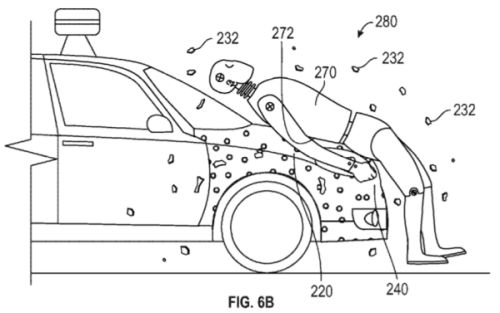Google often boasts about how their self-driving cars have the capability to save lives as they do not crash into things, nevertheless, crashes still do occur and when they do Google has now come up with a backup plan through their patented idea – "human flypaper".
Google has been awarded a patent that suggests positioning a strong, sticky adhesive layer on the hood of Google's autonomous cars. This rather strong and sticky adhesive layer on the hood of the car adheres a pedestrian to the layer during impact, when the car hits a pedestrian or cyclist, thereby preventing the pedestrian from suffering a secondary impact. This essentially means that a pedestrian or cyclist that is hit by one of Google's self-driven cars will happen to find themselves stuck to the cars hood preventing them from being thrown back off the car, hitting the roof of the car, the hard surface of the road or another car (preventing so called "secondary impact"). This secondary impact often causes the most serious injuries during a crash.

Google filed this patent in 2014 and the purpose of its design is to serve as a temporary solution to keep humans around the self-driving cars safe while autonomous technology further improves. The patent filed describes the adhesive layer on the hood of the car to also contain a kind of "eggshell"-like coating so as to stop insects and other smaller animals from sticking to the hood like actual flypaper.
The question on everyone's lips is would this invention work to prevent serious secondary injuries? From a physics standpoint being hit by a car once is much preferable to being hit by a car and then another car or hard surface. The idea of turning cars into large glue traps is certainly a feature that could have urban applications beyond autonomous cars. This idea could potentially be applied to all dangerous moving objects. The idea is basically a variation on an external airbag and on the face of it seems like a rather good idea for a low-speed car as a backup safety measure.
The idea is not flawless and with a pedestrian/cyclist stuck to the front of a car, the car may have trouble moving to safety or may drag the human's limbs under the car, inflicting new injuries. However, another great benefit to this idea besides preventing secondary injuries from occurring is that having a person stuck to the hood of a car may stop a human driver from fleeing the scene of an accident and in doing so reducing the number of hit and runs.
Originally published September 25, 2019
The content of this article is intended to provide a general guide to the subject matter. Specialist advice should be sought about your specific circumstances.

